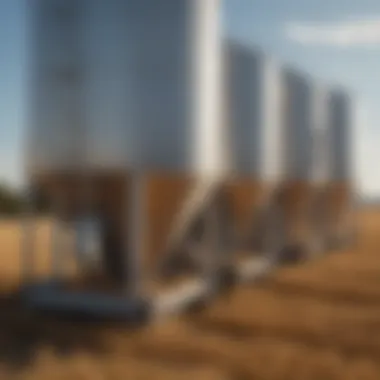Finding Grain Bin Parts Locally: A Complete Guide


Intro
Grain bins play a crucial role in modern agriculture, serving as essential storage facilities for harvested crops. Understanding the various components of these bins is vital for maintaining their functionality and prolonging their lifespan. For farmers and agronomists, sourcing grain bin parts locally not only supports efficient operations but also minimizes downtime during harvesting seasons. This guide will delve into the key components of grain bins, factors affecting procurement, and tips for locating suppliers in your area.
In this article, we will cover the following points:
- The functionality of grain bins and their primary components
- The significance of sourcing parts locally
- Strategies for finding reliable suppliers
- Important pricing considerations and their implications on sourcing
- Maintenance practices that enhance the durability of grain bin systems
Whether you run a small farm or operate on a larger scale, efficient sourcing of grain bin parts can greatly influence your operational productivity. Let's begin by examining the fundamental aspects of grain bins in detail.
Intro to Grain Bin Systems
Grain bin systems play a vital role in the agriculture industry, particularly for farmers and agronomists. These systems are designed to store harvested grains, ensuring they remain safe and protected from pests and spoilage. Understanding grain bins signifies grasping the foundation of effective grain handling. This understanding impacts yield preservation and economic sustainability for farming operations.
The functionality of grain bins goes beyond simple storage. They are engineered to maintain the quality of grains while facilitating ease of access for inspection and distribution. Various models are available, catering to specific types of grains and storage needs. With the right grain bin system in place, farmers can manage their crops efficiently, protecting their investments and optimizing production outcomes.
The historical development of grain handling systems illustrates how far the industry has come. Over time, innovations have occurred to enhance capacity and improve safety measures within grain storage practices, shifting from rudimentary methods to advanced technologies. As a result, today's farmers benefit from sophisticated designs that accommodate larger volumes while reducing labor demands.
Consideration of grain bin systems is essential for any agricultural enterprise aiming for long-term success. As grain production increases globally, the demand for reliable storage solutions follows. Understanding these systems will aid farmers in making informed decisions about their grain storage, ultimately impacting their overall productivity and profitability.
"The right grain bin system is not just a luxury; it is a necessity for modern agriculture."
In the subsequent sections, this guide will delve into the specific components of grain bins, and the variety of available parts, alongside best practices for locating suppliers. This knowledge will serve as a toolkit for farmers looking to enhance their operational efficiency.
Key Components of Grain Bins
The topic of key components of grain bins is crucial for understanding how to manage grain storage effectively. Grain bins are essential for preserving the quality of harvested crops. Whether dealing with corn, soybeans, or wheat, knowing the components helps ensure proper storage. A well-assessed grain bin can prevent spoilage, insect infestations, and other deterioration. Therefore, knowledge of the key components will not only aid in finding parts but also in enhancing operational efficiency for farmers and agronomists.
The Structure and Materials of Grain Bins
The structure of grain bins is typically cylindrical, designed to utilize vertical space efficiently. Most bins are constructed using galvanized steel or aluminum. These materials resist rust and corrosion, which are prevalent in agricultural settings. Additionally, the thickness of the steel plays a vital role in strength and durability. For instance, thicker materials can withstand more pressure from the grains stored inside. A key consideration in choosing a grain bin structure is the local environmental factors, such as wind load and snow load.
Understanding these can guide you in selecting the right bin for your farm. For example, a location with high winds may require bins with added reinforcements.
Essential Parts: Covers, Bases, and Walls
Grain bin components include covers, bases, and walls. Each of these parts has specific functions that contribute to overall bin performance.
- Covers are crucial for protecting the contents from weather elements. A good cover prevents water damage, which can lead to mold and spoilage.
- Bases ensure stable placement of the bin and can help with drainage to prevent moisture accumulation.
- Walls provide structural integrity; they must be strong enough to hold the weight of the grain without warping.
When looking for parts, it is essential to assess the condition of these components regularly.
Ventilation Systems in Grain Bins
Ventilation is another significant aspect of grain bins. Proper ventilation prevents moisture buildup inside the bin, which can create an environment conducive to spoilage. A typical ventilation system includes fans and vents that facilitate airflow.
Benefits of Good Ventilation:
- Controls temperature.
- Reduces humidity.
- Extends storage life of grains.


Ensuring that the ventilation system is functioning correctly is critical for long-term grain preservation.
Grain Handling Equipment Accessories
In addition to the main structure of the grain bin, various accessories support grain handling and storage. These accessories may include:
- Augers for moving grain in and out
- Level indicators to monitor grain height
- Safety ladders and platforms for maintenance access
These accessories enhance the operational effectiveness of grain bins. They streamline processes, reduce labor time, and improve safety.
When sourcing these components locally, ensure they are compatible with your existing systems to avoid costly adjustments or replacements.
Locating Grain Bin Parts Near You
Locating grain bin parts nearby holds significant importance for agronomists and farmers. Proximity to suppliers can enhance efficiency in operations, reduce downtime during repairs, and support timely harvests. Having access to local grain bin parts also means that transportation costs can be minimized. Furthermore, establishing connections with nearby suppliers fosters relationships that can be beneficial in long-term.
In this section, we will explore different strategies to find local suppliers that provide parts for grain bins.
Using Online Directories for Local Suppliers
Online directories serve as a vital resource for finding local suppliers of grain bin parts. Websites like Yellow Pages or Angie's List can be powerful tools. Users can input their location, which results in specific listings of suppliers in close proximity.
In addition, industry-specific platforms often cater to agricultural needs, allowing users to navigate through various options, including:
- Contact details of suppliers
- Customer reviews
- Product availability
These directories allow for initial research, enabling users to compare suppliers based on different aspects such as reputation and pricing. It is crucial, however, to cross-verify the information provided:
"Always confirm that the listed suppliers actualy have the parts you need before making a visit."
Engaging with Cooperative Extensions and Local Networks
Cooperative extensions provide a unique avenue for farmers and agricultural businesses looking to locate grain bin parts. These extensions not only offer expert advice but also promote local networks among farmers. Many of them might possess valuable insights on where to find specific grain bin parts.
Engaging with such networks allows individuals to share information, lead to:
- Recommendations for trustworthy suppliers
- Insights on best practices in sourcing parts
Furthermore, participating in cooperative extension programs can facilitate workshops or events focused on grain management, offering practical experience alongside potential suppliers and experts.
Visiting Agricultural Shows and Trade Events
Agricultural shows and trade events manifest as excellent opportunities to connect directly with suppliers of grain bin parts. These events showcase the latest technologies and advancements in the industry. Attending these gatherings allows farmers to meet suppliers, see new products firsthand, and discuss specific needs.
Additionally, these shows often feature:
- Networking with fellow farmers
- Opportunities to negotiate pricing
- Access to exclusive promotions or discounts
Bringing home a detailed understanding of various products and solutions available in the market can profoundly impact a farmer's operation. For those engaged in agriculture, it is wise to allocate time for such events.


Evaluating Suppliers for Grain Bin Parts
Evaluating suppliers for grain bin parts is a critical step in maintaining and enhancing your grain storage operations. The right supplier can influence both the supply chain efficiency and the quality of the components you incorporate into your systems. Additionally, with the variability of product availability and quality, thorough evaluation ensures you invest in parts that not only meet specifications but also enhance the overall functionality of your grain storage setup.
Understanding the nuances of supplier evaluation helps you make informed decisions. It reduces the risks associated with sourcing parts that may not perform as expected, and it cultivates a supply chain characterized by reliability and trust.
Assessing Quality and Reliability of Parts
When selecting suppliers, a focus on quality and reliability cannot be overstated. Grain bin parts must withstand intense conditions, including weight, pressure, and environmental factors. Therefore, you should prioritize suppliers that demonstrate high manufacturing standards and have a proven track record in the industry.
To assess quality:
- Check certifications and compliance with industry standards.
- Investigate the supplier's history and reputation among other buyers.
- Request samples or detailed specifications of the parts being offered.
Reliability is also crucial. A supplier's ability to deliver on time and maintain consistent stock levels ensures your operations run smoothly. Cross-reference reviews and testimonials. Engaging with previous customers provides insights into the supplier’s reliability metrics.
Understanding Warranty and Return Policies
Clear warranty and return policies are fundamental when dealing with grain bin parts. A transparent warranty supports your confidence in the supplier. This aspect becomes crucial when parts fail to meet operational needs or specifications.
Factor in the following when evaluating warranty policies:
- Duration: Understand how long the warranty lasts and what it covers.
- Terms: Read the conditions attached to the warranty—some may require professional installation.
- Return Process: Know how to initiate returns or exchanges. A well-defined procedure reflects a supplier's customer service quality.
Being aware of these policies protects your investment. If issues arise, a supportive warranty can save you unnecessary costs and operational downtime.
Pricing Considerations for Grain Bin Parts
Understanding the pricing dynamics of grain bin parts is crucial for anyone involved in agricultural operations. This aspect not only affects the overall cost of equipment but also influences budgeting and the financial viability of grain storage systems. Prices can vary widely based on several factors, and being aware of them can lead to better decision making.
Farmers and agronomists should take the time to analyze costs for each component to ensure effective allocation of resources. Evaluating what you need in your grain bin system versus what you can afford is essential.
Factors Affecting Cost of Components
Cost factors for grain bin parts can stem from various sources. Some of these include:
- Material Quality: High-quality materials, such as galvanized steel or aluminum, typically command higher prices due to their durability and resistance to weather-related wear.
- Manufacturing Processes: Parts made using advanced technology or specialized techniques may have increased costs associated with their production.
- Supply Chain Logistics: Transportation fees can escalate the cost, especially for rural suppliers.
- Market Demand: Seasonal changes and the overall agricultural market trends can influence pricing.
- Local Economic Conditions: Prices may vary based on local competition and regional economic conditions.
Understanding these factors allows farmers to make informed procurement decisions. Knowing when to buy or whether to wait for a better price can make a substantial difference.
Budgeting for Maintenance and Repairs
Proper budgeting for grain bin maintenance and repairs is essential for extending the lifespan of the equipment. Farmers need to allocate funds not only for initial parts purchase but also for ongoing upkeep. Here are some considerations:
- Scheduled Maintenance: Plan for regular inspections to identify small issues before they escalate into costly repairs.
- Repair Funds: Set aside a specific amount for unexpected repairs. This fund can help manage financial strain when parts unexpectedly fail.
- Cost of Downtime: Calculate the potential costs associated with downtime due to equipment failure. This could include lost crops or delayed harvests.
- Training and Labor: Don't forget to budget for labor, whether hiring professionals or investing in training for in-house repairs.
A proactive approach can significantly reduce overall expenses associated with grain bin operations. Ensuring you're prepared financially for maintenance not only improves efficiency but ultimately contributes to a more productive and profitable farming operation.
Remember, understanding the financial aspects of grain bin parts is not just about saving money; it's about optimizing investment in agricultural technology to enhance productivity.


The Role of Maintenance in Grain Bin Longevity
Maintaining grain bins is vital for ensuring their longevity and efficiency in storage. Grain bins serve as fundamental facilities in grain handling and storage operations. Regular maintenance helps to preserve their structural integrity, reduce costs associated with repairs, and improve the overall functionality of the storage system.
Investing time and resources in proper maintenance can prevent significant disruptions in grain operations. This is because any failure in the grain bins can lead to severe losses. An approach centered around maintenance can greatly contribute to the sustainability and safety of agricultural practices.
Regular Inspection and Upkeep
Regular inspection is crucial for the health of grain bins. It is recommended to conduct inspections at least twice a year, focusing on key components such as:
- Walls and Roofs: Ensure there are no cracks or breaches in the structure.
- Doors and Seals: Check for proper closure to prevent pest intrusion.
- Ventilation Systems: Inspect fans and ducts for blockages that could affect airflow.
- Electrical Components: Test all electrical wiring and connections to ensure they are functioning as intended.
During inspections, look for signs of damage or wear, which can often go unnoticed. Small issues, if addressed promptly, can prevent larger, costlier problems from arising. A maintenance log can be useful to track inspections, repairs, and parts replacements.
Identifying Common Issues and Solutions
Identifying problems early on can save time and resources. Several common issues may arise in grain bins:
- Rust and Corrosion: This can weaken the structural elements. To combat it, apply coatings or seals that enhance resistance.
- Pest Infestations: Keep an eye out for signs of insects or rodents. Regular cleanings and the use of traps can help in control.
- Blocked Ventilation: Ensure ducts and fans are free from obstruction. This often requires regular cleaning and maintenance.
- Cracks in Concrete or Metal: Small cracks can expand if not repaired. Use appropriate sealants or discuss repairs with experts.
Addressing these issues efficiently strengthens the overall quality and reliability of grain storage. The longevity of grain bins is not merely about sturdy construction but also about routine scrutiny and timely solutions for any mechanical failures.
"An ounce of prevention is worth a pound of cure." Early attention to detail during maintenance can extend the life of grain bins significantly.
Future Trends in Grain Bin Technology
Understanding the future trends in grain bin technology is vital for farmers and those in the agricultural sector. These advancements can greatly enhance the efficiency of grain storage and handling, which is critical for maintaining quality and minimizing loss. With technology rapidly evolving, it becomes crucial to adapt and implement these changes.
Innovations in Grain Storage Solutions
Grain storage is witnessing significant innovations. One notable change is the integration of smart technology within grain bins. This includes sensors that monitor temperature and humidity levels. By analyzing these factors in real-time, users can take appropriate actions to ensure optimal conditions for stored grain. For example, systems like AgriSync allow remote monitoring. Such tools can alert farmers when conditions deviate from the ideal.
Automated systems are also on the rise. Drones and robotics are being used for inspecting grain conditions, which reduces manual labor and enhances accuracy. Another innovation is in materials used for construction. Advanced composites and coatings are now available which provide better insulation and protection against pests. These trends not only improve efficiency but also contribute to the overall safety and quality of stored grain.
Sustainability Practices in Grain Management
As global awareness regarding sustainable practices grows, the agricultural sector, including grain management, is following suit. The focus has shifted to environmentally friendly methods of grain storage. This includes reducing the carbon footprint of grain handling systems. Options such as renewable energy sources, for instance, solar panels, are now being integrated into grain bin systems.
The use of biodegradable materials for packaging grain is another practice gaining traction. Additionally, there is a push for better waste management practices. This includes recycling grain dust and ensuring that all waste is properly dealt with.
Farmers also learn to implement crop rotation and cover crops to maintain soil health. It ensures that the grain storage process aligns seamlessly with broader sustainable farming practices.
"The future of grain storage lies in technological advancements and sustainable practices that prioritize efficiency and environmental considerations."
End
Local sourcing of grain bin parts is not just a matter of convenience; it profoundly impacts efficiency and effectiveness in grain management operations. Understanding the significance of obtaining these essential components from nearby suppliers can lead to better support in terms of shipping, troubleshooting, and maintaining relationships with vendors. When farmers and agronomists choose to source locally, they often benefit from shorter delivery times, which is crucial during peak harvest seasons.
In this guide, we've explored various approaches to finding grain bin parts, emphasizing the need for practical, hands-on solutions tailored to local contexts. By discussing the importance of engaging with community resources, such as cooperative extensions and agricultural shows, we highlighted strategies that empower the agricultural workforce.
Summarizing the Importance of Local Sourcing
Local sourcing of grain bin parts fosters a symbiotic relationship between suppliers and farmers.
- Timely Acquisition: Proximity enables quicker procurement of essential components when emergencies arise.
- Community Support: Local suppliers often have a vested interest in the agricultural community, which translates to better service and support.
- Cost-Effectiveness: Shipping expenses and time delays can escalate prices unexpectedly; local sourcing effectively mitigates these risks.
- Knowledge Sharing: Local vendors may possess unique insights about regional grain handling techniques that can greatly enhance operations.
- Sustainability: Reducing transportation distances aligns with sustainable practices, minimizing environmental impacts.
"Finding the right parts is crucial. But it's equally about building trust and maintaining relationships with those who understand your needs."















